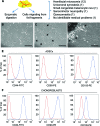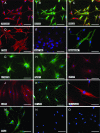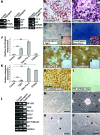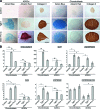High plasticity of pediatric adipose tissue-derived stem cells: too much for selective skeletogenic differentiation?
- PMID: 23197817
- PMCID: PMC3659709
- DOI: 10.5966/sctm.2012-0009
High plasticity of pediatric adipose tissue-derived stem cells: too much for selective skeletogenic differentiation?
Abstract
Stem cells derived from adipose tissue are a potentially important source for autologous cell therapy and disease modeling, given fat tissue accessibility and abundance. Critical to developing standard protocols for therapeutic use is a thorough understanding of their potential, and whether this is consistent among individuals, hence, could be generally inferred. Such information is still lacking, particularly in children. To address these issues, we have used different methods to establish stem cells from adipose tissue (adipose-derived stem cells [ADSCs], adipose explant dedifferentiated stem cells [AEDSCs]) from several pediatric patients and investigated their phenotype and differentiation potential using monolayer and micromass cultures. We have also addressed the overlooked issue of selective induction of cartilage differentiation. ADSCs/AEDSCs from different patients showed a remarkably similar behavior. Pluripotency markers were detected in these cells, consistent with ease of reprogramming to induced pluripotent stem cells. Significantly, most ADSCs expressed markers of tissue-specific commitment/differentiation, including skeletogenic and neural markers, while maintaining a proliferative, undifferentiated morphology. Exposure to chondrogenic, osteogenic, adipogenic, or neurogenic conditions resulted in morphological differentiation and tissue-specific marker upregulation. These findings suggest that the ADSC "lineage-mixed" phenotype underlies their significant plasticity, which is much higher than that of chondroblasts we studied in parallel. Finally, whereas selective ADSC osteogenic differentiation was observed, chondrogenic induction always resulted in both cartilage and bone formation when a commercial chondrogenic medium was used; however, chondrogenic induction with a transforming growth factor β1-containing medium selectively resulted in cartilage formation. This clearly indicates that careful simultaneous assessment of bone and cartilage differentiation is essential when bioengineering stem cell-derived cartilage for clinical intervention.
Figures






Similar articles
-
Chemical group-dependent plasma polymerisation preferentially directs adipose stem cell differentiation towards osteogenic or chondrogenic lineages.Acta Biomater. 2017 Mar 1;50:450-461. doi: 10.1016/j.actbio.2016.12.016. Epub 2016 Dec 9. Acta Biomater. 2017. PMID: 27956359 Free PMC article.
-
Electromagnetic fields enhance chondrogenesis of human adipose-derived stem cells in a chondrogenic microenvironment in vitro.J Appl Physiol (1985). 2013 Mar 1;114(5):647-55. doi: 10.1152/japplphysiol.01216.2012. Epub 2012 Dec 13. J Appl Physiol (1985). 2013. PMID: 23239875
-
Characterization of human adipose-derived stem cells and expression of chondrogenic genes during induction of cartilage differentiation.Clinics (Sao Paulo). 2012;67(2):99-106. doi: 10.6061/clinics/2012(02)03. Clinics (Sao Paulo). 2012. PMID: 22358233 Free PMC article.
-
[Differentiation potential and application of stem cells from adipose tissue].Zhongguo Xiu Fu Chong Jian Wai Ke Za Zhi. 2012 Aug;26(8):1007-11. Zhongguo Xiu Fu Chong Jian Wai Ke Za Zhi. 2012. PMID: 23012940 Review. Chinese.
-
Determinants of stem cell lineage differentiation toward chondrogenesis versus adipogenesis.Cell Mol Life Sci. 2019 May;76(9):1653-1680. doi: 10.1007/s00018-019-03017-4. Epub 2019 Jan 28. Cell Mol Life Sci. 2019. PMID: 30689010 Free PMC article. Review.
Cited by
-
Generation of a Bone Organ by Human Adipose-Derived Stromal Cells Through Endochondral Ossification.Stem Cells Transl Med. 2016 Aug;5(8):1090-7. doi: 10.5966/sctm.2015-0256. Epub 2016 Jun 22. Stem Cells Transl Med. 2016. PMID: 27334490 Free PMC article.
-
Suitability of Ex Vivo-Expanded Microtic Perichondrocytes for Auricular Reconstruction.Cells. 2024 Jan 12;13(2):141. doi: 10.3390/cells13020141. Cells. 2024. PMID: 38247833 Free PMC article.
-
Pluripotent stem cells derived from mouse and human white mature adipocytes.Stem Cells Transl Med. 2014 Feb;3(2):161-71. doi: 10.5966/sctm.2013-0107. Epub 2014 Jan 6. Stem Cells Transl Med. 2014. PMID: 24396033 Free PMC article.
-
Modulation of calcium-induced cell death in human neural stem cells by the novel peptidylarginine deiminase-AIF pathway.Biochim Biophys Acta. 2014 Jun;1843(6):1162-71. doi: 10.1016/j.bbamcr.2014.02.018. Epub 2014 Mar 5. Biochim Biophys Acta. 2014. PMID: 24607566 Free PMC article.
-
Cord blood Lin(-)CD45(-) embryonic-like stem cells are a heterogeneous population that lack self-renewal capacity.PLoS One. 2013 Jun 28;8(6):e67968. doi: 10.1371/journal.pone.0067968. Print 2013. PLoS One. 2013. PMID: 23840798 Free PMC article.
References
-
- Tollefson TT. Advances in the treatment of microtia. Curr Opin Otolaryngol Head Neck Surg. 2006;14:412–422. - PubMed
-
- Tapp H, Hanley EN, Jr, Patt JC, et al. Adipose-derived stem cells: Characterization and current application in orthopaedic tissue repair. Exp Biol Med (Maywood) 2009;234:1–9. - PubMed
-
- Brzoska M, Geiger H, Gauer S, et al. Epithelial differentiation of human adipose tissue-derived adult stem cells. Biochem Biophys Res Commun. 2005;330:142–150. - PubMed
-
- Cao Y, Sun Z, Liao L, et al. Human adipose tissue-derived stem cells differentiate into endothelial cells in vitro and improve postnatal neovascularization in vivo. Biochem Biophys Res Commun. 2005;332:370–379. - PubMed
Publication types
MeSH terms
Substances
Grants and funding
LinkOut - more resources
Full Text Sources
Medical

